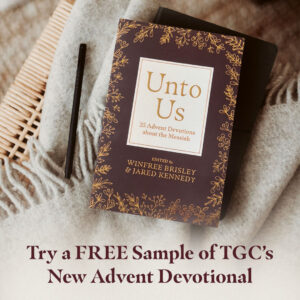The Gospel Coalition’s council, staff, and several thousand of our friends are gathering together this week in Chicago for our national conference, Him We Proclaim: Preaching Jesus and the Gospel from the Old Testament. We thank Tabletalk magazine, published by Ligonier Ministries, for contributing a series of articles this week to our Preaching Christ in the Old Testament project, which is an ongoing extension of this year’s national conference.
John the Baptist was the last of the “Old Testament” prophets, and his message—“Repent, for the kingdom of heaven is at hand”—tells us in a nutshell what the task of the prophets was and how they went about it. Their task was to speak the word God had given them; their objective was a message relevant to their contemporaries; and their method included news of coming events so that people might be forewarned and forearmed. So John said “repent” (a message for the present), and also predicted (“the kingdom is at hand”), so that in the here and now the people might prepare for what was coming.
All the prophets were like that. We are so accustomed to using the word prophecy in the sense of “prediction” that we can fall into the error of seeing Old Testament prophets—and also the New Testament, which looks forward to the second coming—as if they existed so that we could compose a calendar or map of the future. Not so! The prophets looked back to Moses as the “father” of their order. They were not innovators but exponents of the Mosaic deposit of divine truth. They sought to recall a people “prone to wander” back to their roots in the exodus, to walk with God as, for a time, their ancestors had done (Jer. 2:1–3). But in the course of this summons back to revealed religion and ethics, they enhanced their message to the present by alerting people to the future.
But recall this also: though the prophets lived long ago—from Amos (about 750 BC) to Malachi (about 400 BC)—their word is also what the Lord is saying to us. When they proclaimed “Thus says the Lord,” they meant exactly that. Their words were precisely the words the Lord himself would have used if he had spoken in person instead of by the prophets. What a precious deposit we possess, then, in their books. Moses, said Stephen, “received living oracles to give to us” (Acts. 7:38), and Hebrews sees Psalm 95 as something “the Holy Spirit says” (3:7), and urges that, in Jeremiah 31:31–34, “the Holy Spirit bears witness” (10:15). The old word is the present word. The unchanging God addresses us with his unchanged word. Just as the Old Testament people are our ancestors (Gal. 3:29) and the Old Testament history is our pre-history as the people of Jesus, so “whatever was written in former days was written for our instruction” (Rom. 15:4).
Never tire, then, of reading and re-reading the prophets. If a passage seems at first sight puzzling, ask the question, why did the prophet say this? Usually each passage contains the answer, but in any case Proverbs 2:4–6 is true for the whole Bible: knowledge is in the gift of God, and he gives it to those who search his Word as if looking for hidden treasure.
We must turn now to a particular “treasure” in the books of the prophets: how, like Abraham (John 8:56), they rejoiced over the coming day, the coming Person, and the coming new heaven and new earth. But remember, they offered no dates. They were not composing a calendar; rather, they were calling us to present commitment to the Word of God, in expectation of the glory yet to be.
Amos saw the messianic future through the spectrum of the Lord’s covenant with David (2 Sam. 7:16; Ps. 89:24–37): Davidic rule, world dominion, the restored creation, settled existence, eternal security (Amos 9:11–15; see Gal. 6:16). The land-based promises of Amos 9:14–15 are to be understood in the light of Jesus’ affirmation that his kingdom is not of this world (John 18:36), and in the light of the New Testament teaching that the Jerusalem in question is the heavenly city to which we already belong (Heb. 12:22; Gal. 4:21–26 ) and which is yet to be (Rev. 22:9–10). This idea of land recovery is prominent in Obadiah, also, when he says that the Lord’s people will “possess their possessions” (vv. 17, 19–21).
Just a word here about prediction and fulfillment. Think of a perennial flowering plant. The first year’s flowers are delightful but meager. It takes some years of maturing for the full flower to bloom, yet the full flower was present, in embryo, in the first flower. There is continuity and development, but no contradiction. The full flower was what the first flower was always intended to be. Just so, the kingdom not of this world, the heavenly and eternal city, is what the gift of the land and the city were always meant to be. In this sense, what we usually call “fulfillment” is really “perfecting” and “maturing,” the ultimate “realization” of what was always there from the start.
In focusing on the coming “David,” Amos affirmed the main line of prediction. Micah follows the same theme, foretelling that Messiah would be born in Bethlehem (5:2), and, interestingly, he adds but does not develop a reference to the Messiah’s mother, his work as shepherd, and his position as “their peace” (vv. 3–5; see Eph. 2:14–18).
Micah’s contemporary, Isaiah, was the chief prophet of the Messiah. His book consists of a threefold portrait. Against the background of the failure of King Ahaz, Isaiah affirmed the certainty of the Lord’s promise of a true king in the line of David (chaps. 7–12); in the light of Hezekiah’s sin in turning from the way of faith in God’s promises (38:4–6) to the way of self-reliance (39:1–4), Isaiah preached a message of comfort (40:1), and foresaw “the Servant of the Lord” who would bear away sin (52:13–53:12); and, knowing that his people would return unchanged from Babylon, still under the rule of a foreign king, he foresaw the anointed Conqueror bringing in both salvation and vengeance, a figure with whom the Lord Jesus identified himself (61:1–2; see Luke 4:16–21) and which he will consummate at His return (2 Thess. 1:7–10).
Isaiah’s royal Messiah is born of a virgin (Isa. 7:14; see Matt. 1:18–25), a word to be taken in its plain meaning. His very birth brings light, joy, and liberation (Isa. 9:2–6); His name proclaims him the supernatural one (“wonderful,” v. 6)—indeed, he is God himself (v. 7; 10:21), bringing peace and the worldwide, endless rule pledged to David (v. 7). His rule is in righteousness (11:2–5) over the new earth (vv. 6–9), and he is the faithful one, for he is both “shoot” and “root” of David’s father, Jesse (vv. 1, 10). Isaiah’s third portrait, the anointed Conqueror (59:21; 61:1–3; 61:10–62:12; 63:1–6), elaborates the kingly portrait in terms of salvation for his people and vengeance on all foes, setting up the new heaven and the new earth (65:17–25).
Isaiah is best known for his central portrait of the Servant of the Lord. This Spirit-filled Servant brings “justice” (literally, “judgment,” that is, what the Lord has decided upon and revealed as his truth) to the Gentile world (42:1–4). But he has a wider task also: to bring the Lord’s professing people who have lost their way and their peace back to him (48:22; 49:1–6). The Servant obediently endures the direst suffering (50:4–9), and this suffering (52:13–53:12) proves to be the way of salvation, a substitutionary sin-bearing (53:4–6, 12) along with the imputation of his righteousness (53:11). In this way, Isaiah saw the full maturing of the first flowering in the atoning sacrifices of Leviticus. It was given to him to realize that ultimately only a person can be the substitute for a people. He called that person the Servant of the Lord; we call him Jesus (Isa. 53:12; see Luke 22:37).
Jeremiah and Ezekiel add their testimony to Isaiah’s picture of the Servant and the truth of a blood-bought salvation. Jeremiah saw the messianic future in terms of a new covenant (Jer. 31:31–34; see Heb. 10:15–18). He did not explain how it would be that the Lord would forgive our iniquities and remember our sin no more. No doubt he was relying on the explanation Isaiah had already given. Ezekiel was a priest (Ezek. 1:3) who saw the future in terms familiar to him—the perfection of the Lord’s temple in the midst of the Lord’s gathered people (chaps. 40–48). These chapters are not an architect’s specification of a temple to be built, but a prophet’s statement of truth in priestly terms. We can gather to the holy God only where sacrifice is offered and where there is priestly ministry to offer it. Ezekiel’s vision is fulfilled in Ephesians 2 and Hebrews 7:1–8:6.
Please let this brief review wet your appetite and encourage you to be thrilled at the miracle of inspiration whereby the Messiah was seen with such perfect accuracy so long before his advent. The abundance of the predictions underlines the uniqueness of the Lord Jesus and the age-long working of the sovereign God.
Try Before You Buy: FREE Sample of TGC’s New Advent Devotional
 Choosing the right Advent daily devotional can be tough when there are so many options. We want to make it easier for you by giving you a FREE sample of TGC’s brand-new Advent devotional today.
Choosing the right Advent daily devotional can be tough when there are so many options. We want to make it easier for you by giving you a FREE sample of TGC’s brand-new Advent devotional today.
Unto Us is designed to help you ponder the many meanings of this season. Written by TGC staff, it offers daily Scripture readings, reflections, and questions to ponder. We’ll send you a free sample of the first five days so you can try it out before purchasing it for yourself or your church.



























